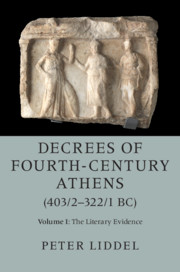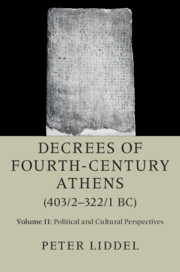Refine search
Actions for selected content:
23990 results in Ancient history
Chapter 2 - Embedding Contexts of Roman Money
-
- Book:
- Economic Theory and the Roman Monetary Economy
- Published online:
- 03 February 2020
- Print publication:
- 20 February 2020, pp 20-50
-
- Chapter
- Export citation
Chapter 1 - On Writing Roman Economic History
-
- Book:
- Economic Theory and the Roman Monetary Economy
- Published online:
- 03 February 2020
- Print publication:
- 20 February 2020, pp 1-19
-
- Chapter
-
- You have access
- HTML
- Export citation
Dedication
-
- Book:
- Economic Theory and the Roman Monetary Economy
- Published online:
- 03 February 2020
- Print publication:
- 20 February 2020, pp v-vi
-
- Chapter
- Export citation
Conclusion
-
- Book:
- Economic Theory and the Roman Monetary Economy
- Published online:
- 03 February 2020
- Print publication:
- 20 February 2020, pp 173-176
-
- Chapter
- Export citation
Chapter 3 - Evidence and Theory
-
- Book:
- Economic Theory and the Roman Monetary Economy
- Published online:
- 03 February 2020
- Print publication:
- 20 February 2020, pp 51-74
-
- Chapter
- Export citation
Chapter 4 - Rationality, Purposefulness and Action
-
- Book:
- Economic Theory and the Roman Monetary Economy
- Published online:
- 03 February 2020
- Print publication:
- 20 February 2020, pp 75-109
-
- Chapter
- Export citation
Preface
-
- Book:
- Economic Theory and the Roman Monetary Economy
- Published online:
- 03 February 2020
- Print publication:
- 20 February 2020, pp ix-xiv
-
- Chapter
- Export citation
Chapter 6 - Understanding Money Use and Value
-
- Book:
- Economic Theory and the Roman Monetary Economy
- Published online:
- 03 February 2020
- Print publication:
- 20 February 2020, pp 142-172
-
- Chapter
- Export citation
Index
-
- Book:
- Economic Theory and the Roman Monetary Economy
- Published online:
- 03 February 2020
- Print publication:
- 20 February 2020, pp 204-208
-
- Chapter
- Export citation
List of Figures
-
- Book:
- Economic Theory and the Roman Monetary Economy
- Published online:
- 03 February 2020
- Print publication:
- 20 February 2020, pp viii-viii
-
- Chapter
- Export citation
Chapter 5 - Money Quantity and Quality
-
- Book:
- Economic Theory and the Roman Monetary Economy
- Published online:
- 03 February 2020
- Print publication:
- 20 February 2020, pp 110-141
-
- Chapter
- Export citation
Acknowledgments
-
- Book:
- Economic Theory and the Roman Monetary Economy
- Published online:
- 03 February 2020
- Print publication:
- 20 February 2020, pp xv-xvi
-
- Chapter
- Export citation
Bibliography
-
- Book:
- Economic Theory and the Roman Monetary Economy
- Published online:
- 03 February 2020
- Print publication:
- 20 February 2020, pp 177-203
-
- Chapter
- Export citation

Decrees of Fourth-Century Athens (403/2-322/1 BC)
-
- Published online:
- 18 February 2020
- Print publication:
- 05 March 2020

Decrees of Fourth-Century Athens (403/2–322/1 BC)
-
- Published online:
- 18 February 2020
- Print publication:
- 05 March 2020

Economic Theory and the Roman Monetary Economy
-
- Published online:
- 03 February 2020
- Print publication:
- 20 February 2020
Acknowledgements
-
- Book:
- The Imperialisation of Assyria
- Published online:
- 24 January 2020
- Print publication:
- 30 January 2020, pp xiii-xiv
-
- Chapter
- Export citation
Dedication
-
- Book:
- The Imperialisation of Assyria
- Published online:
- 24 January 2020
- Print publication:
- 30 January 2020, pp v-vi
-
- Chapter
- Export citation
Two - A City at the Fringe?
-
- Book:
- The Imperialisation of Assyria
- Published online:
- 24 January 2020
- Print publication:
- 30 January 2020, pp 27-40
-
- Chapter
- Export citation
Copyright page
-
- Book:
- The Imperialisation of Assyria
- Published online:
- 24 January 2020
- Print publication:
- 30 January 2020, pp iv-iv
-
- Chapter
- Export citation
